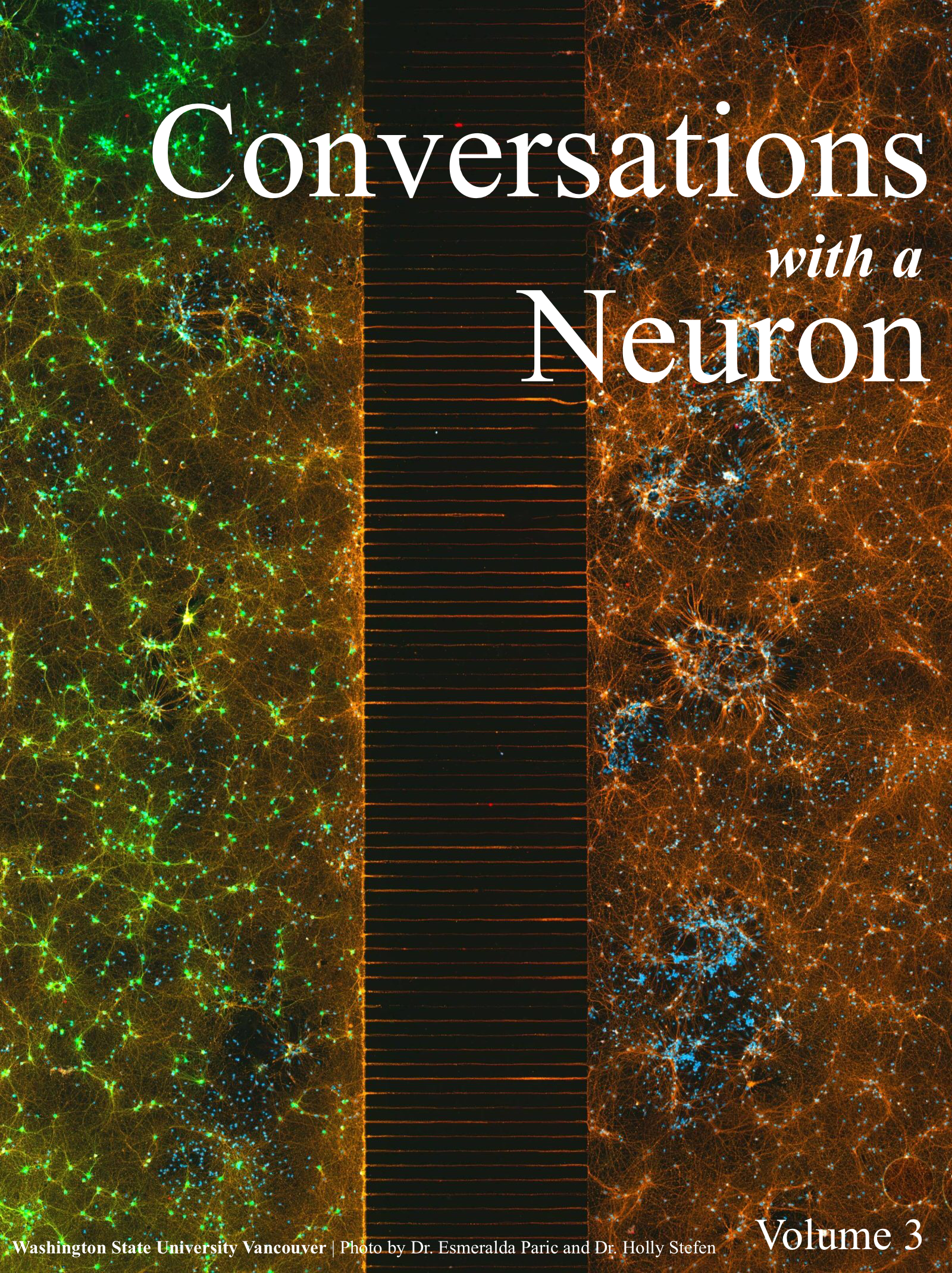Conversations with a Neuron, Volume 3
[-] Preface
Welcome to the third edition of Conversations with a Neuron! We launched this journal in 2019 to feature articles written by our Neuroscience majors at Washington State University Vancouver. The articles all started as class assignments for classes such as Neuroanatomy and the Neuroscience Capstone course; upper-division courses that invite the students to dig into a topic in neuroscience that interests them, to think deeply, and to synthesize ideas. The end result, of course, is a graded assignment – we know our students work hard for their grades. In a traditional course, the grade would be the end – a paper written by the student, read and graded by the professor, and set aside.
These papers are so much more than a chance to earn a grade. They show original thought and mastery of the subject matter, and they teach the professors something new every time. Hence, this journal. We wanted to showcase the great work of our students. We also want to highlight the importance of science – including neuroscience – in the face of ongoing global challenges. The past few years have showcased the importance of science in society. These articles help bring those connections to life.
I particularly want to thank Editor-in-Chief Emily Dale, an excellent writer and current neuroscience major, for her editing on this volume. Also, special thanks to Cheyanne Lewis (B.S. Neuroscience 2019), our inaugural editor who paved the way for this edition and those to come. Finally, thanks to all of our students who wrote these pieces from home during the height of the pandemic as your tried to navigate our changing world as best you could. Your work matters. This is your chance to shine.
To learn more about our Neuroscience program, please visit our website at https://cas.vancouver.wsu.edu/neuroscience.
We hope you enjoy this issue… and learn something you are glad to know!
Sincerely,

Dr. Allison Coffin
Associate Professor of Neuroscience
[+] Neuroanatomy
Auditory Adderall: Auditory Beat Stimulation and Memory
Modulation of neuronal activity in the auditory pathway using binaural 5 Hz beat firing differences improves recall memory, focus, and anxiety in a non-invasive manner.
Brain Games: Effects of Video Games on Brain Structure
Increase in time spent playing violent video-games is negatively correlated with gray matter volumes in those with a video game addiction (VGA). Significant reduction in both gray and white matter intensity are expressed in those with VGA.
Can Taurine Make Alcohol Withdrawal a Tad Bit More Bearable for Your Brain?
Alcohol plus energy drinks sound like a party . . . except when you’re going through alcohol withdrawal. Worry not–that fresh can of taurine might still help your GABA and NMDA receptors heal through withdrawal. Or can it?
Detangling Prion Disease: Promising Research Hints at Future Treatments
Prion infected nervous tissue treated with resveratrol experienced both the eradication of disease and amelioration of the recovering tissue’s microenvironment.
Do Children with ADHD and Normal Motor Cortex Physiology Present Behavioral Dysfunction?
A new study presents that children with ADHD show normal motor cortex physiology; however, with reduced short interval cortical inhibition across the behavioral states. Moreover, there is an association between ADHD symptoms and reduced task-related-up-modulation during response selection and inhibition.
Do You Like Your Sleep or Are You Too Dependent on Coffee?
A study further shows how caffeine affects the brain and causes people to be alert and more aroused with the blockage of the Adenosine A2A receptors (A2ARs). The study also found that there are some Adenosine A2A receptors (A2ARs) located in the Nucleus Accumbens (NAc) shell.
Empathy & Oxytocin: Prairie Voles
This study examines the ability for prairie voles to feel empathy and consolation towards one another (Burket et al. 2016). As a socially complex animal, but cognitively less advanced than other mammals, it was not thought that rodents experienced empathy—this study researches the extent to which prairie voles feel empathy and express consolation behaviors to other, stressed, prairie voles.
Fetal Alcohol Syndrome: Who’s Really at Fault?
A new study shows that mice born to fathers who consumed alcohol prior to conception showed decreases in learning and coordination and misexpressed genes.
Finding the Supreme Mouse Model for Anxiety Disorders.
129s1/Svlmj mice show sleep pattern similar to those with anxiety and PTSD.
How Can You Tell if a Mouse is Hallucinating?
Researchers were able to produce and measure hallucination-like perception in mice.
How Gaps Between Cells Can Help Fight Cancer
A new study shows that gaps between cells can be the next tool to fight cancer development due to electricity properties.
How Glutamatergic Proteins Influence the Maturation and Development of the Human Visual Cortex
Ketamine: Horse Tranquilizer, Human Antidepressant
The study examines how ketamine is able to quickly block lateral habenula activity to alleviate depressive symptoms. Previously, it was known that ketamine was an effective rapidly acting antidepressant, but the way it worked was not understood.
Meditation Helps Reduce Anxiety
A study shows that mindfulness meditation can improve symptoms in Generalized Anxiety Disorder.
Melody to The Ears of Premature Infants
A study on the how music exposure for premature infants in the Neonatal Intensive Care Unit (NICU) have significant increased coupling between brain networks. The salience network with superior frontal, auditory, and sensorimotor networks; which is similar to those of full-term newborns.
Natural Killer Cells in Amyotrophic Lateral Sclerosis
In this study the subgroup of familial ALS (fALS) disorder was investigated by studying the presence of the mutant superoxide dismutase 1 (SOD1) gene with respect to Natural killer (NK) cells in the death of motor neurons (11). This study included both ALS patients and SOD1 mice and concluded that the presence of NK cells was correlated with ALS symptoms and ALS markers such as damaged microglia and the suppression of protective cells.
Omega-3 Fatty Acids May Change Your Eating Habits by Protecting the Striatum
Getting enough omega-3 fatty acids in the diet can help stop obesity induced cellular damage in the striatum that could cause harmful eating habits.
Possible Treatment for Psychiatric Disorders Using a Hallucinogenic Drug
Psychiatric disorders cause distortions to the idea of self-representation and communication in real-world functioning situations, and often show progression with no effective treatment. Administrations of lysergic acid diethylamide (LSD) can possibly be used to create positive alterations to self-representation and to the areas of the ‘social brain’.
Repetitive Transcranial Magnetic Stimulation: Palliative Treatment of the Future?
A new study finds reductions in symptom severity in borderline personality disorder patients after 3 weeks of rTMS on the dorsomedial prefrontal cortical area.
Sleep Less, Remember Less
Researchers have shown that the dendritic spine density in the hippocampus, a structure important for memory, was increased with lack of sleep which is related to weaker memory consolidation.
The Hypothalamic Switch
Neurons inside the hypothalamus of rats may prove as an indicator to whether or not the rat is experiencing REM or non-REM sleep.
The Impact That Language Exposure has on Children’s Brains
This study evaluates the relationship of children’s language experience to the development of white matter microstructural relationship with conversational turns.
The Two Subtypes of Parkinson’s Disease
This article shows that Parkinson’s disease has two subtypes; brain-first and body-first. The body-first subtype seems to have a highly predictive marker of premotor RBD.
[+] Neurophysiology
An LSD Substitute: Reaping the Therapeutic Benefits with None of the Trip
Substances like ketamine and LSD have shown to be promising candidates for fast-acting antidepressants. These substances, however, can produce psychedelic experiences or “trips”, which can have negative psychological consequences in some people. A new study shows that it is possible to develop non-hallucinogenic variations of these substances to treat addiction and depression.
Big Brain or Small Brain: The Effects of Alcohol on Total Brain Volume
Increased alcohol consumption is linked to decrease in total brain volume in those aged 39 to 45, and were classified as moderate drinkers.
Diagnosing Autism Spectrum Disorder: There’s an App for that!
Researchers study the potential to use a digital app on a phone as a screening tool to assist in the diagnosis of Autism Spectrum Disorder (ASD).
Dyno Tuning Your Neurons
A new study shows implanting artificial neurons into the brain can be used as a deep brain stimulator treatment to restore failing brain circuits within neurodegenerative disease. The artificial neurons and synapses can be linked to machines and be controlled over the internet.
Examining the Relationship Between the Membrane Flow and Cytoskeleton Model of Cell Migration in Neural Crest Cells
Impact of Air Pollution on the Brain
Exposure to diesel exhaust particles causes neuroinflammation, impaired memory, and anxious behaviour in mice.
Investigation of metaneuromodulation involved in the swimming behavior of Xenopus laevis Tadpoles
Frequency of swimming in Xenopus laevis tadpoles is determined by the balance between synaptic excitation and inhibition in the neural circuitry. Outputs of spinal networks is accomplished by intrinsic, extrinsic, and meta modulation (McLean, 2004).
Live to Smell Again: SARS-CoV-2 Induced Anosmia and Regeneration of Olfactory Neurons and Epithelium.
This article examines research done to deduce the regenerative capability of olfactory cells in the inner lining of the nose after contracting COVID-19. Using Syrian golden hamsters as test subjects, the study carefully measures the layer of cells after COVID-19-induced cell deaths and the related phenomena in loss of the ability to smell odors (Urata et al. 2021).
Minipig’s Affliction is a Sucrose Addiction
This article provides new evidence that decreased binding of carfentanil in the nucleus accumbens and cingulate cortex occurs in Gottingen minipigs after exposure to sucrose.
Molecular Biomarkers in Multiple Sclerosis to Save Lives
Multiple sclerosis (MS) is a disease that causes disability in young adults. Many researchers are finding possible biomarkers to identify MS in its early stages, that slowly progress the symptoms that are associated with this disease. There are currently no possible cures but early diagnoses and treatment can help with pain management, reduce the frequency and severity of MS attacks. Increase in immunoglobulin G (IgG) and presence of oligoclonal bands (OCB) in the cerebral spinal fluid (CSF) is shown to be a reliable and common indicator of MS in patients and other biomarkers are evaluated.
Neuroinflammation Following Myocardial Infarction Supports Heart-Brain Axis Theory
Activation of neuroinflammatory cells in mouse brains following occlusion of the coronary artery show neurotoxic effects of cardiac ischemic injury.
Plasticizers Disrupt Neuro Signaling in Adult Brains
Readily used plasticizers such as BPA and BPS alter neurotransmission in the brains of goldfish.
Potential Mechanism for Delayed Motor Learning in Autism
New research suggests that delayed motor learning commonly seen in autism may be associated with noradrenaline levels in the primary motor cortex.
Preventing Misdiagnosis of Multiple Sclerosis with CVS (No, Not the Pharmacy)
An MRI biomarker was shown to largely prevent misdiagnosis of multiple sclerosis in a real world demonstration of its efficacy.
Schizophrenia and the Leaky Blood Brain Barrier
Researchers looked at the relationship between the 22q11.2 deletion syndrome (22qDS) and schizophrenia. Their results showed that 22qDS schizophrenia may be the result of a compromised blood brain barrier (BBB).
Stress and the Amygdala: Does Size Matter?
A brain imaging study explored whether the size of students’ amygdalae affect intensity of stress they experience.
Treatment of Emotional Disorders Utilizing Transdiagnostic Cognitive-Behavioral Therapy
Using CRISPR to Convert Glia into Neurons
A new study uses the CRISPR CasRx system to convert glia into functioning neurons as a way to treat neurodegenerative disease.
Vestibular Implants: One (Literal) Step Closer to Artificial Senses
A new study shows that individuals who suffer from vestibular dysfunction can now be treated using a newly developed inner ear implant.
[+] Neuroscience In Review

Chief Editor: Emily Dale
Publication Date: Sep 2021
Supervising Staff: Allison Coffin, PhD & Dale Fortin, PhD
Download: PDF